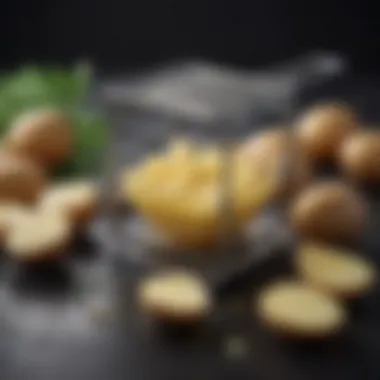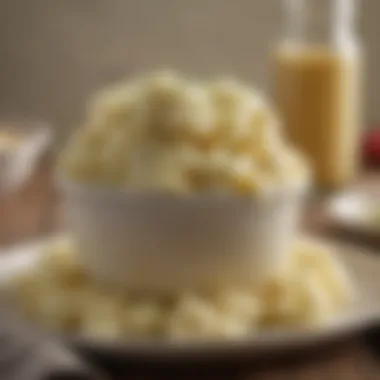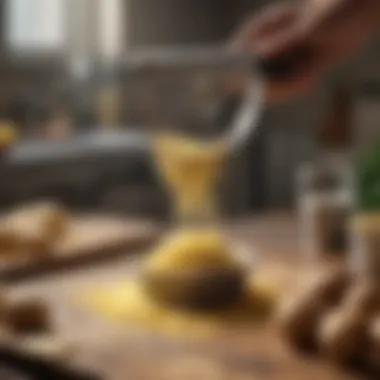The Ultimate Potato Ricer Guide for Busy Cooks


Intro
In familiar culinary spaces, a potato ricer stands as a significant tool that often gets overlooked. It is essential for those who appreciate the nuance of flavor and texture in their cooking. As home cooks and gourmets alike seek efficiency without sacrificing quality, understanding the benefits of this often underestimated tool becomes paramount. This guide delves into how a simple potato ricer can elevate your cooking experience, turning mundane mashed potatoes into a delight.
Utilizing a potato ricer offers an array of advantages that transcend traditional methods. Knowing how to select the right one aligns with one's culinary aspirations. With proper utilization and care, a potato ricer can play a pivotal role in creating delectable textures essential for creating high-quality meals, especially amidst a busy lifestyle.
Let's explore the myriad features, practical applications, and vital product considerations that impact meal preparation and culinary satisfaction.
Recipe Overview
While potato ricer may not typically present a specific recipe like complicated dishes, it enhances countless savory and sweet meals. However, to illustrate its function distinctly, consider the preparation of Classic Creamy Mashed Potatoes.
- Yield: 4 servings
- Preparation Time: 15 minutes
- Cooking Time: 20 minutes
- Difficulty: Easy
- Main Ingredients: Potatoes, butter, cream, salt, and pepper.
Step-by-Step Instructions
To prepare creamy mashed potatoes that fully utilize the textural potential of a potato ricer, proceed as follows:
- Select Quality Potatoes: Choose Yukon Gold or Russet potatoes. These varieties become fluffy when cooked.
- Peel and Cut: Remove skins and cut potatoes uniformly into 1-inch pieces for even cooking.
- Boil: Place them in a pot, cover with water, add a pinch of salt, and bring to a boil. Cook for approximately 15 minutes.
- Ricing Process: Drain the potatoes and let them rest briefly. Work in batches to transfer them into the ricer. Squeeze the ricer to create smooth potato strands into a mixing bowl.
- Add Ingredients: Combine the riced potatoes with warm butter and cream, mixing gently until creamy. Season with salt and pepper to taste.
By employing this straightforward process, home cooks can maximize the benefits offered by a potato ricer, ensuring the final dish is velvety and hash-free.
Nutritional Information
The nutritional profile of classic mashed potatoes prepares well for culinary health awareness.
- Calories per Serving: Approximately 220 calories
- Carbohydrates: 36 grams
- Proteins: 4 grams
- Fats: 8 grams
These mashed potatoes also provide vitamins such as Vitamin C, B6, and potassium. Overall, while potatoes are a carb dense food, using a ricer ensures they are lighter, making them ideal for various dietary programs.
Quick Cooking Tips
- To save time, cook your potatoes and prep other components concurrently—chop your additional ingredients while the potatoes boil.
- Consider microwaving potatoes to cut down on cooking time. Cut them into pieces and wrap in a damp paper towel before microwaving.
- Use substitutions when necessary; for a lighter version, swap cream with Greek yogurt or alternate milk options.
Related Recipes & Variations
- Garlic Parmesan Mashed Potatoes: Simple addition for garlic flavor elevates your classic dish.
- Vegan Mashed Potatoes: Swap the butter and cream with vegan options for an entirely plant-based experience.
- Encourage experiments with flavors; herb-infused olive oil or smoked paprika allow for unique twists on the traditional presentation.
By utilizing a potato ricer effectively in preparation, the dish experience shifts, providing both flavors and innovative cooking styles.
Understanding the Potato Ricer
Grasping the concept of a potato ricer is essential for culinary enthusiasts aiming to produce perfectly textured dishes consistently. This tool can transform how one prepares not just potatoes but various vegetables as well. Understanding the functionalities and applications of the potato ricer can lead to better meal presentation and delicious outcomes.
What is a Potato Ricer?
A potato ricer is a kitchen tool that resembles a large garlic press. It enables the user to create smooth, fluff-textured potato purée or vegetable mash. The ricer operates through a simple mechanism: the user places cooked potatoes or veggies into a chamber and then compresses them through small holes, resulting in a consistent, airy mash. Unlike traditional masher, which might leave lumps, a ricer provides a finer texture, crucial for recipes like gnocchi or certain pastries where texture is paramount.
Potato ricers come in different designs and sizes, but each functions similarly, making it possible for cooks to achieve uniformity and quality.
History of the Potato Ricer
The potato ricer’s origins are somewhat obscure but can be traced back to European kitchens in the mid-20th century. This tool reflected a shift towards efficient and practical cooking equipment, responding to the need for persistence in refining textures in Italian and French cuisine.
Initially, kitchen items such as mortars, pestles, and manual mashers served the purpose of mashing vegetables. However, as chefs sought more consistency, the ricer came into vogue. Its design was likely influenced by the need to produce smooth products in either restaurant settings or domestic kitchens where hosting dinners demanded visually appealing presentations.


Throughout the years, the functionality of the ricer has broadened, incorporating messy items such as squash or sweet potatoes into the same refinement process. It has cemented its place as a vital tool in modern culinary practices, making it indispensable for many hosuses.
A potato ricer stands as an essential tool, reflecting historical advancements in culinary precision and innovation.
Understanding the potato ricer is not just about the tool itself but also about its capability to elevate the quality of meals prepared. Knowing its purpose and history enhances one's appreciation of this transformative kitchen instrument.
Key Features of a Good Potato Ricer
The potato ricer is an essential kitchen tool for any culinary enthusiast. Understanding its key features can help in selecting a unit that enhances meal prep efficiency and the quality of the final dish. Various attributes distinguish a good potato ricer, such as material quality, design considerations, and ease of use. Each of these aspects plays an important role in ensuring optimal performance and longevity.
Material Quality
When choosing a potato ricer, material quality is fundamental. A ricer made with high-grade stainless steel will resist rust and wear, maintaining its functionality over time. This metal offers durability and can withstand the pressure required to create perfect, creamy potatoes or other vegetables. It's wise to avoid plastic models that may warp with heat or break under pressure. A solid construction is crucial not only for the ricer's lifespan but also for the comfort during use. Look for a ricer that has comfortable grips made from heat-resistant materials to prevent slipping when applying significant force.
Design Considerations
Design can greatly affect how well a potato ricer performs. A good ricer should be ergonomically shaped to allow for intuitive handling. Consider features such as long handles, which can make it easier to press ingredients without straining your hands. A model with multiple disc options is beneficial. Different disc sizes will help you adjust the texture of the mashed potatoes to your preference, from coarse to smooth, enabling versatility in various dishes. Additionally, a ricer that is easier to assemble and disassemble simplifies the process of switching out discs or cleaning.
Ease of Use
Ease of use encompasses factors that enhance user experience. A top-tier potato ricer should provide an efficient way to prepare food with minimal effort. Select a ricer with a design that allows the user to leverage body weight rather than relying solely on arm strength. This
Comparing Potato Ricers with Other Tools
When it comes to kitchen tools for preparing potatoes, a potato ricer stands out. However, many cooks may still find themselves wondering how it compares to other common devices like potato mashers or food processors. In this section, we explore these tools to help clarify their uses, benefits, and drawbacks. Understanding these differences not only supports informed purchasing decisions but also enhances one’s culinary efficiency.
Potato Masher vs.
Potato Ricer
The potato masher is perhaps the most familiar option for many home cooks. Its primary function is to crush and mash the potatoes until they reach a desired consistency. It comes in various forms, including stainless steel and plastic versions. However, its effectiveness largely depends on the user’s technique.
A potato ricer, on the other hand, works differently. The ricer pushes cooked potato through a grid-like disk, producing a fine, fluffy texture that a masher cannot achieve. This method incorporates air into the potato, which often results in smoother mashed potatoes.
Key Differences
- Texture: Ricers create a creamier, lighter texture. Mashers can lead to heavy, lump-filled results.
- Time and Effort: While a masher requires elbow grease, the ricer can save time and produce consistent results with less physical effort.
- Cleaning: Potato ricers often have more spaces and require more effort to clean than simple, flat mashers.
In summary, while a potato masher may suffice for straightforward recipes, a potato ricer promotes elevated food quality. Those seeking exceptional results, especially in more gourmet settings, may prefer investing in a potato ricer.
Food Processor vs.
Potato Ricer
Food processors are notable kitchen appliances. They can chop, slice, and puree various ingredients seamlessly. Seen as a more versatile tool, food processors have applications that go far beyond potato prep. However, when focusing on creating perfect mashed potatoes or processed vegetables, they may not always shine.
Using a food processor for potatoes can result in overworking the ingredients, leading to a gummy texture. Consequently, this would be the flaw when creating creamy mashed potatoes—texture becomes a hampered journey. A potato ricer maintains the integrity of the ingredient through a gentle press without excessive input.
Considerations for Use
- Versatility: Food processors can handle a range of tasks; however, this may dilute the purpose of perfecting mashed potatoes.
- Results: Users often find that ricers deliver superior texture compared to a food processor, especially under stringent conditions.
- Space and Maintenance: Food processors require more kitchen space and cleaning preparation, while a ricer is more compact.
Both potato ricers and food processors have their places in a modern kitchen. Ultimately, the expert choice depends on whether the focus is on versatility or optimizing texture for potatoes.
As cooking techniques evolve, recognizing the unique capabilities of each tool can empower cooks to refine their culinary skills, making meal prep efficient and rewarding.
Practical Applications in the Kitchen


Understanding the practical applications of a potato ricer is crucial for anyone invested in streamlining their kitchen tasks. The functionality of a ricer can greatly enhance various culinary processes. Using a potato ricer offers a consistent and fine texture that is difficult to achieve with standard methods. By incorporating this tool into your routine, you can save time while elevating the taste and presentation of dishes.
Preparing Mashed Potatoes
Using a potato ricer for preparing mashed potatoes significantly improves the texture. Unlike traditional potato mashers that can produce lumps, a ricer guarantees a silky-smooth finish. This is fundamental for both comfort foods and gourmet dishes alike. To prepare mashed potatoes with a ricer, start by peeling and boiling your potatoes until fork-tender. Once cooked, let the potatoes cool slightly before passing them through the ricer. This step ensures that there are no chunks.
Additionally, the light and airy texture achieved by using a ricer allows the potatoes to easily absorb butter and cream, resulting in richer flavors.
- Benefits: Silky texture, improved flavor absorption
- Tips: Work with hot potatoes, add warm milk or cream for best results
A potato ricer makes not just food preparation easier but also transforms ordinary meals into extraordinary dining experiences.
Utilizing for Other Vegetables
Beyond potatoes, a ricer can be an excellent tool for preparing other vegetables. Items like cauliflower or carrots can easily be processed for creamy purées. This can be especially useful in households focusing on health or dietary needs. For example, when making cauliflower purée, the ricer transforms floret pieces into a smooth texture that mimics mashed potatoes without the carb content.
Other vegetables that can be effectively used with a ricer include:
- Squash: Great for soups or saucing
- Sweet Potatoes: Offers a unique taste combination
- Turnips: Provides an underlying earthiness
These preparations can enrich a dish’s nutritional profile while adding engaging variations to standard recipes.
Making Gourmet Dishes with a Ricer
The potato ricer shines in creating gourmet dishes that require finesse. For instance, restaurants frequently utilize this tool to produce flavorful purées and refined plates. Using a ricer allows a chef to achieve greater precision in texture without excessive effort.
Dishes like gnocchi can greatly benefit from using a potato ricer. Instead of dough feeling dense, light ricers create a fluffy bite that complements sauces beautifully. Furthermore, using a ricer in plating contributes to impressive visuals, guiding diners' eyes and proving why aesthetics matter in culinary arts.
Selecting the Right Potato Ricer
Selecting the right potato ricer is fundamental for enhancing culinary efficiency and quality in meal preparation. Choosing the appropriate tool ensures that the user achieves the desired texture and consistency in mashed potatoes and other riced vegetables without unnecessary effort. It is vital to consider several factors like personal usage, pricing, and brand reputation when making a choice. This guide aims to provide a deep understanding of these aspects to assist culinary enthusiasts in their decision-making process.
Identifying Personal Needs
Each cook has different preferences and cooking styles, thus identifying personal needs becomes an essential first step. Someone who frequently makes mashed potatoes for a large family may prioritize ricer’s capacity and ease of cleaning, whereas a professional chef might seek versatility for various vegetables. Reflect on the volume of food prepared and the specific textures desired.
- Volume: Consider how often you cook. For frequent usage, a larger capacity ricer is ideal.
- Recipes: Determine what you intend to prepare. For instance, a model with interchangeable discs may allow for more diverse culinary applications.
- Hand Strength: Think about the physical effort required. A lightweight design can accommodate users of all ages and abilities.
Price Considerations
Price is often a decisive factor in any kitchen tool selection. A well-made potato ricer need not be exorbitantly priced, but low-cost options may sacrifice durability and functionality. Identify a balance between quality and what fits within your budget. Investing in a more durable option could provide long-term savings by reducing the replacement frequency.
- Budget Range: Define your budget ahead of time to guide your search effectively.
- Dollar vs. Value: Analyze if higher-priced models offer features that are legitimately beneficial for your cooking needs.
- Warranty: Some ricers come with warranties which may justify a higher price point, adding assurance.
Brand Reputation
Focusing on brand reputation is critical; well-established brands may offer reliability and quality assurance that lesser-known brands may not. Research reviews and recommendations before making your final decision. Understanding which brands consistently produce high-quality kitchen tools can prevent dissatisfaction later.
- Customer Reviews: Sites like Reddit and cooking communities can provide insights into user experiences with various brands.
- Industry Recognition: Established forums and websites may highlight brands that carry credibility based on past performance.
- Customer Service: Occasionally, well-regarded brands offer robust support in case of issues, elevating the user experience.
It is advisable to remember that while a potato ricer appears to be a simple tool, the right selection influences culinary joy significantly.
Identifying personal needs, analyzing price considerations, and understanding brand reputation allows the consumer to navigate the options effectively and make a satisfying purchase. As cooking preferences can vary greatly, ensuring all aspects are considered is crucial for enhancing one's kitchen experience.
Maintaining Your Potato Ricer
Maintaining a potato ricer is as important as choosing the right one. Proper maintenance increases the lifespan of your tool while also ensuring that it operates effectively. A well-cared-for ricer can provide consistent results, allowing for smooth, fluffy textures in your mashed potatoes and other dishes. This section focuses on cleaning techniques and storage recommendations.


Cleaning Techniques
Cleaning your potato ricer should be a straightforward task. Given the nature of the food it processes, it is essential to tackle leftover residue promptly. Here are some effective cleaning methods:
- Immediate Rinse: After using the ricer, rinse it under hot water to remove as much residue as possible. This helps prevent the starch from hardening.
- Soaking: If stubborn bits remain, soak the ricer in warm soapy water for about 10 to 15 minutes. Baking soda can be added to boost the cleaning process.
- Gentle Scrubbing: Use a soft sponge or dish brush to remove any residual food particles. Avoid abrasive scrubbers as they can scratch the surface.
- Dishwasher Safe: Many ricers are dishwasher safe, so check the manual. Using the top rack can protect it from intense heat and potential damage.
Remember to always dry the ricer thoroughly to avoid rusting, especially if it is made from metal.
Storage Recommendations
Proper storage of your potato ricer can affect its performance over time.
- Avoid High Humidity: Store the ricer in a dry place. High humidity can lead to rust or other forms of corrosion.
- Drawer or Container: Form a specific spot in your kitchen drawer or cabinet to keep your ricer. Using a storage container can protect it from dust and damage.
- Keep It Accessible: Make sure to store it in an easily accessible place. Ricing can become a common step in your cooking, and having the tool close at hand will encourage its frequent use.
"A clean tool is a pleasure to use, leading to a better culinary experience."
By taking these steps toward proper maintenance, you can ensure your potato ricer remains a dependable tool in your kitchen arsenal.
Common Mistakes and How to Avoid Them
Understanding the pitfalls while using a potato ricer is crucial for achieving the desired culinary results. Mistakes can lead to unsatisfactory textures or wasted ingredients, which is what every culinary enthusiast seeks to avoid. Proper technique not only enhances the quality of your dishes but also elevates the overall cooking experience. In this section, we will delve into two of the most common errors encountered with potato ricers and provide clear guidance to help you navigate around them.
Overworking the Ingredient
One common mistake is overworking the potatoes when using a ricer. This can cause the starches to become too gummy, resulting in a gluey texture that is not only unappetizing but also undesirable for dishes like mashed potatoes. The key to avoiding this is to ricer the potatoes gently and just until they achieve the desired consistency. Often, a light and uniform pressing is sufficient. Here are a few tips to help maintain that ideal texture:
- Work in smaller batches: This allows for more control over the process, preventing the temptation to over-press.
- Use warm, not hot against your skin potatoes: Cooking potatoes appropriately can impact their texture. Warm potatoes lend better results than piping hot ones.
- Rotate the ricer as you press: Changing the angle helps ensure an even press without over-straining any particular part of the potato.
If you can keep these ridiculous tips in mind when working with your ricer, you are more likely to produce creamy and light mashed potatoes.
Overworking roots tends to compromise their quality and leave you with textures similar to school cafeteria meal.
Ignoring Texture Differences
Another significant error is the failure to recognize and adapt to the different textures various potato types can offer. For instance, russet potatoes, when consistently mixed, yield an entirely distinguishable result compared to Yukon Gold or red varieties. Each potato has its own moisture content and starch levels, which directly affects the outcome when ricers are utilized. To assist in preventing texture-related errors, consider the following points:
- Choose the right type of potato for your dish: Selecting waxy potatoes for dishes requiring light fluffiness versus starchy ones can lead to diverse outcomes. Russets are highly recommended for items like mashed potatoes due to their starchy nature.
- Adjust moisture according to exterior factors: Humidity and even the potato’s original freshness can influence the moisture level. Keep an eye out for variations that may lead to undesirable textures.
- Experiment with mixing: Sometimes, mixing different types of potatoes can achieve exciting flavors and textures that enrich your culinary creation.
By keeping these considerations in mind, your mastery of using a potato ricer will surely improve aphatically, ensuring your kitchen endeavors are consistently rewarding, enjoyable, and nutritious.
Closure
In this article, we've delved deep into the multifaceted nature of the potato ricer and its enviable place in the kitchen. This tool, though simple in design, serves a critical function in elevating the cooking experience. The benefits of integrating a potato ricer into your culinary repertoire are notable, from producing the finest mashed potatoes to helping prepare intricate gourmet dishes.
The ability to create food with the perfect texture cannot be overstated. When mashed potatoes are consistently creamy rather than chunky, it results in elevated aesthetics and enhanced flavors.
Also, the conversation of appliance redundancy in kitchens often brings the potato ricer to the forefront. There are numerous options available to chefs; however, the unique texture and taste that a ricer provides cannot be fully appreciated without practical experience. Having different kitchen tools support a culinary approach multidisciplinary yet precise, opening possibilities unseen if relying solely on other methods.
"A potato ricer is not just a tool; it is the gateway to a new culinary experience."
As we have discussed, not just can one leverage a potato ricer for potatoes, but it extends to use other vegetables and pastas alike, providing an admirable multifunctional application. Care for the ricer could prolong its life. Proper maintenance ensures that this indispensable gadget remains in top working order, providing delicious results meal after meal.
In reflection, adopting high-quality equipment is fundamental. The right potato ricer saves time in preparation while ensuring meals that taste gourmet, even when faced with a busy schedule. The discussion focuses not just on selecting a tool, but acknowledging its role within the workplace of the kitchen. By investing wisely, culinary enthusiasts can make choices that reflect their personal needs. Knowledge gained enhances confidence in appliance choices for future cooking endeavors.
Final Thoughts
As you walk through the realm of culinary exploration, integrating a potato ricer could become a linchpin in your cookign approach. Enhancing textures in meals adds sophistication with ease. The simplicity wrapped in this piece of kitchenware allows versatility that reshapes your culinary objectives efficiently. Choosing wisely should reflect how and what you aim for in meal preparation.
Employing resources mentioned in this guide, as well as further searches for niche branding or innovative designs might provide further insights fulfilling your kitchen’s needs. Continuous experimentation will always lead to mastery.
Key Takeaways
- The potato ricer brings diverse applications, reshaping traditional cooking practices.
- Ensuring you understand its essential features can make all the difference in meal quality.
- Proper care results in a longer lifespan for your kitchen tools with improved culinary outcomes.
- Investing time in identifying your needs translates into better selections, further developing your culinary skills over time.
- Embracing the potato ricer can lead to enhanced flavors and textures, simplifying even gourmet cooking in the modern kitchen.







